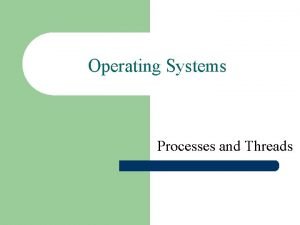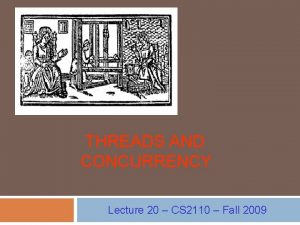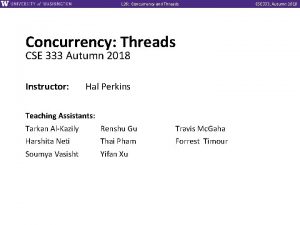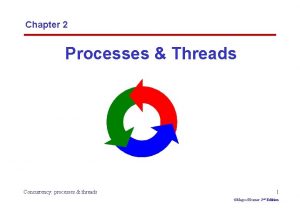THREADS AND CONCURRENCY Lecture 22 CS 2110 Fall







![Example 8 public class Thread. Test extends Thread { public static void main(String[] args) Example 8 public class Thread. Test extends Thread { public static void main(String[] args)](https://slidetodoc.com/presentation_image_h2/1d70cf23ad784e16f5ac36a2185c57af/image-8.jpg)
![Example 9 public class Thread. Test extends Thread { public static void main(String[] args) Example 9 public class Thread. Test extends Thread { public static void main(String[] args)](https://slidetodoc.com/presentation_image_h2/1d70cf23ad784e16f5ac36a2185c57af/image-9.jpg)
![Example 10 public class Thread. Test extends Thread { public static void main(String[] args) Example 10 public class Thread. Test extends Thread { public static void main(String[] args)](https://slidetodoc.com/presentation_image_h2/1d70cf23ad784e16f5ac36a2185c57af/image-10.jpg)




















- Slides: 30

THREADS AND CONCURRENCY Lecture 22 – CS 2110 – Fall 2013

What is a Thread? 2 A separate “execution” that runs within a single program and can perform a computational task independently and concurrently with other threads Many applications do their work in just a single thread: the one that called main() at startup But there may still be extra threads. . . . Garbage collection runs in a “background” thread GUIs have a separate thread that listens for events and “dispatches” upcalls

What is a Thread? 3 A thread is a kind of object that “independently computes” Needs to be created, like any object Then “started”. This causes some method (like main()) to be invoked. It runs side by side with other thread in the same program and they see the same global data The actual execution could occur on distinct CPU cores, but doesn’t need to We can also simulate threads by multiplexing a smaller number of cores over a larger number of threads

Concurrency 4 Concurrency refers to a single program in which several threads are running simultaneously Special problems arise They see the same data and hence can interfere with each other, e. g. if one thread is modifying a complex structure like a heap while another is trying to read it In cs 2110 we focus on two main issues: Race conditions Deadlock

Thread class in Java 5 Threads are instances of the class Thread Can create many, but they do consume space & time The Java Virtual Machine created the thread that executes your main method. Threads have a priority Higher priority threads are executed preferentially A newly created Thread has initial priority equal to the thread that created it (but can change)

6 Creating a new Thread (Method 1) class Prime. Thread extends Thread { long a, b; Prime. Thread(long a, long b) { this. a = a; this. b = b; } overrides Thread. run() } public void run() { //compute primes between a and b. . . } If you were to call run() directly no new thread is used: the calling thread Prime. Thread p = new Prime. Thread(143, 195); will run it. . . but if you create a new object and p. start(); then call start(), Java invokes run() in new thread

7 Creating a new Thread (Method 2) class Prime. Run implements Runnable { long a, b; Prime. Run(long a, long b) { this. a = a; this. b = b; } public void run() { //compute primes between a and b. . . } } Prime. Run p = new Prime. Run(143, 195); new Thread(p). start();
![Example 8 public class Thread Test extends Thread public static void mainString args Example 8 public class Thread. Test extends Thread { public static void main(String[] args)](https://slidetodoc.com/presentation_image_h2/1d70cf23ad784e16f5ac36a2185c57af/image-8.jpg)
Example 8 public class Thread. Test extends Thread { public static void main(String[] args) { new Thread. Test(). start(); for (int i = 0; i < 10; i++) { System. out. format("%s %dn", Thread. current. Thread(), i); } } public void run() { for (int i = 0; i < 10; i++) { System. out. format("%s %dn", Thread. current. Thread(), i); } } } Thread[Thread-0, 5, main] Thread[main, 5, main] 0 Thread[main, 5, main] 1 Thread[main, 5, main] 2 Thread[main, 5, main] 3 Thread[main, 5, main] 4 Thread[main, 5, main] 5 Thread[main, 5, main] 6 Thread[main, 5, main] 7 Thread[main, 5, main] 8 Thread[main, 5, main] 9 Thread[Thread-0, 5, main] Thread[Thread-0, 5, main] Thread[Thread-0, 5, main] 0 1 2 3 4 5 6 7 8 9
![Example 9 public class Thread Test extends Thread public static void mainString args Example 9 public class Thread. Test extends Thread { public static void main(String[] args)](https://slidetodoc.com/presentation_image_h2/1d70cf23ad784e16f5ac36a2185c57af/image-9.jpg)
Example 9 public class Thread. Test extends Thread { public static void main(String[] args) { new Thread. Test(). start(); for (int i = 0; i < 10; i++) { System. out. format("%s %dn", Thread. current. Thread(), i); } } public void run() { current. Thread(). set. Priority(4); for (int i = 0; i < 10; i++) { System. out. format("%s %dn", Thread. current. Thread(), i); } } } Thread[main, 5, main] 0 Thread[main, 5, main] 1 Thread[main, 5, main] 2 Thread[main, 5, main] 3 Thread[main, 5, main] 4 Thread[main, 5, main] 5 Thread[main, 5, main] 6 Thread[main, 5, main] 7 Thread[main, 5, main] 8 Thread[main, 5, main] 9 Thread[Thread-0, 4, main] Thread[Thread-0, 4, main] Thread[Thread-0, 4, main] 0 1 2 3 4 5 6 7 8 9
![Example 10 public class Thread Test extends Thread public static void mainString args Example 10 public class Thread. Test extends Thread { public static void main(String[] args)](https://slidetodoc.com/presentation_image_h2/1d70cf23ad784e16f5ac36a2185c57af/image-10.jpg)
Example 10 public class Thread. Test extends Thread { public static void main(String[] args) { new Thread. Test(). start(); for (int i = 0; i < 10; i++) { System. out. format("%s %dn", Thread. current. Thread(), i); } } public void run() { current. Thread(). set. Priority(6); for (int i = 0; i < 10; i++) { System. out. format("%s %dn", Thread. current. Thread(), i); } } } Thread[main, 5, main] 0 Thread[main, 5, main] 1 Thread[main, 5, main] 2 Thread[main, 5, main] 3 Thread[main, 5, main] 4 Thread[main, 5, main] 5 Thread[Thread-0, 6, main] Thread[Thread-0, 6, main] Thread[Thread-0, 6, main] Thread[main, 5, main] 6 Thread[main, 5, main] 7 Thread[main, 5, main] 8 Thread[main, 5, main] 9 0 1 2 3 4 5 6 7 8 9

Example waiting. . . 11 running. . . waiting. . . public class Thread. Test extends Thread { running. . . static boolean ok = true; waiting. . . running. . . public static void main(String[] args) { waiting. . . new Thread. Test(). start(); running. . . for (int i = 0; i < 10; i++) { waiting. . . System. out. println("waiting. . . "); running. . . yield(); waiting. . . } If threads happen to running. . . be sharing ok = false; waiting. . . } a CPU, yield allows other waiting running. . . threads to run. But ifwaiting. . . there are public void run() { running. . . multiple cores, yield isn’t needed while (ok) { waiting. . . System. out. println("running. . . "); running. . . yield(); waiting. . . } running. . . System. out. println("done"); done } }

Terminating Threads is tricky 12 Easily done. . . but only in certain ways The safe way to terminate a thread is to have it return from its run method If a thread throws an uncaught exception, whole program will be halted (but it can take a second or too. . . ) There are some old APIs but they have issues: stop(), interrupt(), suspend(), destroy(), etc. Issue: they can easily leave the application in a “broken” internal state. Many applications have some kind of variable telling the thread to stop itself.

Threads can pause 13 When active, a thread is “runnable”. It may not actually be “running”. For that, a CPU must schedule it. Higher priority threads could run first. A thread can also pause It can call Thread. sleep(k) to sleep for k milliseconds If it tries to do “I/O” (e. g. read a file, wait for mouse input, even open a file) this can cause it to pause Java has a form of locks associated with objects. When threads lock an object, one succeeds at a

Background (daemon) Threads 14 In many applications we have a notion of “foreground” and “background” (daemon) threads Foreground threads are the ones doing visible work, like interacting with the user or updating the display Background threads do things like maintaining data structures (rebalancing trees, garbage collection, etc) On your computer, the same notion of background workers explains why so many

Race Conditions 15 A “race condition” arises if two or more threads access the same variables or objects concurrently and at least one does updates Example: Suppose t 1 and t 2 simulatenously execute the statement x = x + 1; for some static global x. Internally, this involves loading x, adding 1, storing x If t 1 and t 2 do this concurrently, we execute the statement twice, but x may only be incremented once

Race Conditions 16 Suppose X is initially 5 Thread t 1 LOAD X Thread t 2 ADD 1 . . . LOAD X ADD 1 STORE X . . . after finishing, X=6! We “lost” an update

17 Settings where race conditions matter Two or more threads try to access something, and one or more want to change it A for-each loop is iterating over a collection, but some thread modifies the collection concurrently You want your program to do one thing at a time, e. g. so that the user can fill in a form without being interrupted to fill in some other form … this list is very partial!

Race Conditions 18 Race conditions are bad news Sometimes you can make code behave correctly despite race conditions, but more often they cause bugs And they can cause many kinds of bugs, not just the example we see here! A common cause for “blue screens”, null pointer exceptions, damaged data structures

Example – A Lucky Scenario 19 private Stack<String> stack = new Stack<String>(); public void do. Something() { if (stack. is. Empty()) return; String s = stack. pop(); //do something with s. . . } Suppose threads A and B want to call do. Something(), and there is one element on the stack 1. thread A tests stack. is. Empty() false 2. thread A pops ⇒ stack is now empty 3. thread B tests stack. is. Empty() ⇒ true 4. thread B just returns – nothing to do

Example – An Unlucky Scenario 20 private Stack<String> stack = new Stack<String>(); public void do. Something() { if (stack. is. Empty()) return; String s = stack. pop(); //do something with s. . . } Suppose threads A and B want to call do. Something(), and there is one element on the stack 1. thread A tests stack. is. Empty() ⇒ false 2. thread B tests stack. is. Empty() ⇒ false 3. thread A pops ⇒ stack is now empty 4. thread B pops ⇒ Exception!

Synchronization 21 Java has one “primary” tool for preventing these problems, and you must use it by carefully and explicitly – it isn’t automatic. Called a “synchronization barrier” We think of it as a kind of lock Even if several threads try to acquire the lock at once, only one can succeed at a time, while others wait When it releases the lock, the next thread can acquire it You can’t predict the order in which contending threads will get the lock but it should be “fair” if priorities are the same

22 Java synchronizations: several forms… One popular option is called a Semaphore An object: Semaphore my. Sema = new Semaphore(n); my. Sema. acquire() – locks the semaphore. n+1’st call will block (e. g. if n was 0, first call will block, etc) my. Sema. release() – unlocks the semaphore object Simple and popular, but can be a bit “unstructured” and in complex code, a common source of problems

Solution – with synchronization 23 private Stack<String> stack = new Stack<String>(); public void do. Something() { synchronized (stack) { if (stack. is. Empty()) return; String s = stack. pop(); } //do something with s. . . } synchronized block • Put critical operations in a synchronized block • The stack object acts as a lock • Only one thread can own the lock at a time

24 Second Solution – Object Locking • You can lock on any object, including this public synchronized void do. Something() {. . . } is equivalent to public void do. Something() { synchronized (this) {. . . } }

Synchronization+priorities 25 Combining mundane features can get you in trouble Java has priorities. . . and synchronization But they don’t “mix” nicely High-priority runs before low priority . . . The lower priority thread “starves” Even worse. . . With many threads, you could have a second high priority thread stuck waiting on that starving low priority thread! Now both are starving. . .

Fancier forms of locking 26 Java developers have created various synchronization ADTs Semaphores: a kind of synchronized counter Event-driven synchronization The Windows and Linux and Apple O/S all have kernel locking features, like file locking But for Java, synchronized is the core mechanism

Deadlock 27 The downside of locking – deadlock A deadlock occurs when two or more competing threads are waiting for oneanother. . . forever Example: Thread t 1 calls synchronized b inside synchronized a But thread t 2 calls synchronized a inside synchronized b

Finer grained synchronization 28 Java allows you to do fancier synchronization But can only be used inside a synchronization block Special primatives called wait/notify

wait/notify 29 Suppose we put this inside an object called animator: boolean is. Running = true; public synchronized void run() { must be synchronized! while (true) { while (is. Running) { //do one step of simulation } relinquishes lock on animator – try { awaits notification wait(); } catch (Interrupted. Exception ie) {} is. Running = true; public void stop. Animation() { } animator. is. Running = false; } } notifies processes waiting for animator lock public void restart. Animation() { synchronized(animator) { animator. notify(); } }

Summary 30 Use of multiple processes and multiple threads within each process can exploit concurrency Which But may be real (multicore) or “virtual” (an illusion) when using threads, beware! Must lock (synchronize) any shared memory to avoid non-determinism and race conditions Yet synchronization also creates risk of deadlocks Even with proper locking concurrent programs can have other problems such as “livelock” Serious treatment of concurrency is a complex topic (covered in more detail in cs 3410 and cs 4410)
 01:640:244 lecture notes - lecture 15: plat, idah, farad
01:640:244 lecture notes - lecture 15: plat, idah, farad Aqap 2110 latest edition
Aqap 2110 latest edition čos 051672
čos 051672 Matrix diagram
Matrix diagram Ppol 2110
Ppol 2110 Raisecom wifi
Raisecom wifi Rotary distretto 2110 organigramma
Rotary distretto 2110 organigramma Me 2110
Me 2110 Millog henkilöstö
Millog henkilöstö Process and threads
Process and threads Process and threads
Process and threads Sockets and threads
Sockets and threads What is thread in operating system
What is thread in operating system Concurrency control and recovery
Concurrency control and recovery Pengertian concurrency
Pengertian concurrency Communication and concurrency
Communication and concurrency Safety and liveness in concurrency
Safety and liveness in concurrency Transactions and concurrency control in distributed systems
Transactions and concurrency control in distributed systems Transaction and concurrency control in dbms
Transaction and concurrency control in dbms Example of concurrency control in dbms
Example of concurrency control in dbms Special segments and points of concurrency
Special segments and points of concurrency Transaction management and concurrency control
Transaction management and concurrency control C11 threads
C11 threads Java shared memory between threads
Java shared memory between threads Conventional representation of threads
Conventional representation of threads A flexible flat material made by interlacing threads/fibers
A flexible flat material made by interlacing threads/fibers Escalonamento por prioridades
Escalonamento por prioridades Os threads
Os threads Vinaya pitaka is a sacred text of
Vinaya pitaka is a sacred text of Needle like threads of spongy bone
Needle like threads of spongy bone Epri iwc
Epri iwc






















































